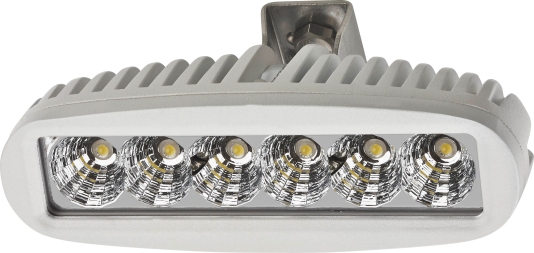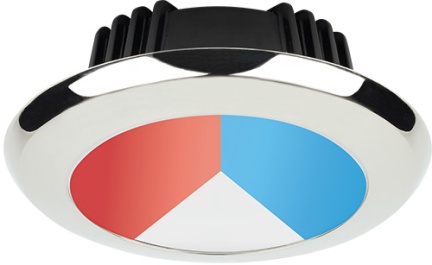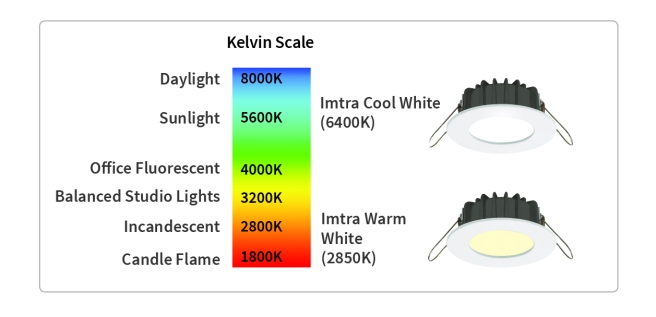Imtra’s lighting expert Colby Chevalier explains the key differences between LED and Halogen lighting for boats.
Over the last several years boat builders and owners all over the world have been switching the light fixtures within their boats from halogen and incandescent lighting to LED light fixtures and bulbs. This trend begs the question, why? In this article we will discuss the advantages and disadvantages to LED lighting, and why you might consider converting your boat to LED.
Wattage vs. Lumens
To compare LED lighting to Halogen and Incandescent lighting, we must first understand the key terms used to describe the two: wattage and lumens.
Wattage – Simply put, wattage measures how much energy is consumed by the fixture or bulb. This can also be measured in Amperes (commonly: Amps), for which the equation is: Amps = Watts / Volts, or Watts = Volts x Amps. While halogen and incandescent bulbs are most commonly rated by wattage, this does not actually describe the amount of light the bulb is outputting.
Lumens – This is the key term used to describe light output, and most commonly how LED bulbs and fixtures are rated and described. It is a fixed number, measured only in a lighting sphere, and is not related to distance away from that fixture. If a light puts out 200 lumens, it does so at 10’ or 100’ away.
In some instances you will see two ratings; “Raw Lumens” and “Fixture Lumens”. Raw lumens refer to the lumen output of the individual LED operating with no obstruction. Fixture lumens refer to the light output of the whole fixture, accounting for any inefficiencies of the fixture like a frosted lens or a reflector within the fixture. Fixture lumens are more important to consider when comparing lights, as this rating is the actual amount of light you will see.
What are the main advantages to using LED lights?
Power Consumption – LED light fixtures and bulbs are far more power-efficient than their halogen equivalents. For example, an LED fixture with a light output equivalent to a 25-watt halogen bulb may actually consume only 4 or 5 watts. If your boat has 20-30 fixtures on board, that power savings really adds up, and reduces the number of DC batteries needed to power the circuit or the frequency at which the batteries need to be recharged.
If you’re a cruiser that spends more time at anchor or on a mooring than you do plugged into a dock, this energy saving means less time spent running your engine or generator to keep your boat lit up at night. This is particularly true for sailors who don’t spend much time running the engine while underway.
Focused Direction – Halogen and Incandescent lighting use a heated filament to emit light. That filament, as it heats up, emits lights in all directions equally, meaning that downlight with a filament bulb is throwing just as much light upwards into the body of the fixture, as downwards towards the space it is meant to illuminate.

By comparison, an LED fixture uses diodes which emit light in only one direction. This means an LED fixture would emit light only in the specific direction it is intended to. This means very little of the light output is wasted by throwing light in directions the fixture isn’t intended to throw light.
Multi-Color Options – Because an LED fixture is a collection of light-emitting-diodes secured to an LED-driver-board, they are easily made to be multi-colored by populating that board with diodes that emit different colors. This means one LED fixture or bulb is capable emitting multiple light colors.

Conversely, halogen and Incandescent bulbs can emit only the color the filament produces when electricity runs through it. The means a halogen or incandescent fixture must use multiple bulbs, or colored lenses to emit multiple colors.
Lifespan – The industry standard for the lifespan of an LED fixture is roughly 50,000 hours. As anyone who has used filament-style bulbs in their home or boat knows, halogen and incandescent bulbs do not last nearly that long.
One reason for this is the fragility of a filament. If a halogen or incandescent bulb shakes or vibrates, there’s a chance the filament will break causing the bulb to fail. LED fixtures are solid-state, so vibrations do not harm the light. This lower rate of failure means there’s no need to waste valuable storage space on your boat to keep spare bulbs.
What are the main disadvantages to using LED lights?
Cost – While the quality of the bulb or fixture plays a large role, the cost of an LED product is likely to be more expensive than an equivalent halogen or incandescent product. At the end of the day an LED fixture is a piece of electronics, with many sub-components that add to the cost. A halogen or incandescent fixture only needs to pass electricity through a filament, so the simplicity of it makes it easier to manufacture, resulting in a lower cost.

Dimming – While most quality LED fixtures and bulbs are dimmable, the process by which they are dimmed is different from that of halogen or incandescent bulbs. A filament bulb is dimmed simply by decreasing the amount of electricity that passes through it. That means the dimmer required is a simple device like a rotary knob that either increases or decreases the amount of electricity that reaches the bulb.
Because LED fixtures are essentially electronic devices, they are dimmed using a digital signal called Pulse Width Modulation (PWM) that is essentially turning the light off and back on so rapidly that it is not perceived by the human eye. Because this process is a bit more complicated, the dimming modules required to dim LEDs are often more expensive.
The difference in dimming processes becomes a particular disadvantage for re-fitting your boat from halogen to LED if you use dimming. It means that not only the fixtures or bulbs must be replaced, but also the dimmer and often the switch that controls the dimming as well.
Light Color – While it’s more of a matter of personal preference and perception, some people do feel that the light emitted from an LED is too harsh, or bright. While evolving LED technology has started eliminating this issue, there are still many LED fixtures and bulbs that struggle to replicate the “warm” glow of a halogen or incandescent bulb. When choosing an LED, it is always important pay attention to the color temperature of the bulb or fixture, which is measured in Kelvin. The warm color of an incandescent bulb is around 2800K. If you’re looking for an LED fixture that will replicate that warm color, make sure you check that the LED has a temperature near 2800K.

Is it worth it to convert my boat to LED lighting?
To determine whether or not you should convert your boat’s lighting to LED, be sure to keep these factors in mind.
Do you use your boat at night?
It’s an obvious question, but be sure to consider how often you really have a need to use the lights on your boat. If you’re only turning them on one or two times per year, it’s probably not worth the cost and effort to convert to LED.
What is the demand on your battery, and how often do you need to charge?
Your use of battery power is an important consideration. If you’re someone that’s constantly running your engine or generator to charge your batteries, you may want to consider LEDs to reduce the demand on the batteries, meaning you won’t have to charge as often.
How many fixtures does your boat have?
The number of fixtures matters for two reasons. From a power consumption standpoint, if you have many halogen or incandescent fixtures, converting to LEDs will result in a big savings in power consumption.
From a cost standpoint, replacing many halogen or incandescent fixtures with LED fixtures could stretch your budget thin.
These are just a few questions to consider when contemplating converting your boat from halogen or incandescent to LED lighting. Of course, the overall “project list” for your boat will also come into play, along with your budget, type of boat, and boating habits.
For more info on LED lighting, check out our article The Benefits & Challenges of Installing LED Lights on Your Boat